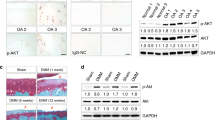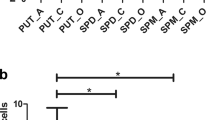Abstract
Polyamines are naturally occurring, positively charged polycations which are able to control several cellular processes in different cell types, by interacting with negatively charged compounds and structures within the living cell. Functional genomics in rodents targeting key biosynthetic or catabolic enzymes have revealed a series of phenotypic changes, many of them related to human diseases. Several pieces of evidence from the literature point at a role of polyamines in promoting chondrocyte differentiation, a process which is physiological in growth plate maturation or fracture healing, but has pathological consequences in articular chondrocytes, programmed to keep a maturational arrested state. Inappropriate differentiation of articular chondrocytes results in osteoarthritis. Thus, we have studied the effects of exogenously added spermine or spermidine in chondrocyte maturation recapitulated in 3D cultures, to tease out the effects on gene and protein expression of key chondrogenesis regulatory transcription factors, markers and effectors, as well as their posttranscriptional regulation. The results indicate that both polyamines are able to increase the rate and the extent of chondrogenesis, with enhanced collagen 2 deposition and remodeling with downstream generation of collagen 2 bioactive peptides. These were able to promote nuclear localization of RUNX-2, the pivotal transcription factor in chondrocyte hypertrophy and osteoblast generation. Indeed, samples stimulated with polyamines showed an enhanced mineralization, along with increased caspase activity, indicating increased chondrocyte terminal differentiation. In conclusion these results indicate that the polyamine pathway can represent a potential target to control and correct chondrocyte inappropriate maturation in osteoarthritis.





Similar content being viewed by others
Abbreviations
- AR-S:
-
Alizarin red-S
- DDR:
-
Discoidin domain receptors
- DFMO:
-
α-Difluoromethylornithine
- ECM:
-
Extra-cellular matrix
- FBS:
-
Fetal bovine serum
- GAG:
-
Glycosaminoglycans
- GAPDH:
-
Glyceraldehyde-3-phosphate dehydrogenase
- KD:
-
Knockdown
- MMP:
-
Matrix metalloproteinase
- OA:
-
Osteoarthritis
- ODC:
-
Ornithine decarboxylase
- PCR:
-
Polymerase chain reaction
- PTH:
-
Parathormone
References
Aeschlimann D, Wetterwald A, Fleisch H, Paulsson M (1993) Expression of tissue transglutaminase in skeletal tissues correlates with events of terminal differentiation of chondrocytes. J Cell Biol 120(6):1461–1470
Agostinelli E, Tempera G, Molinari A, Salvi M, Battaglia V, Toninello A, Arancia G (2007) The physiological role of biogenic amines redox reactions in mitochondria. New perspectives in cancer therapy. Amino acids 33(2):175–187
Bachrach U (2005) Naturally occurring polyamines: interaction with macromolecules. Curr Protein Pept Sci 6(6):559–566
Borzi RM, Mazzetti I, Marcu KB, Facchini A (2004) Chemokines in cartilage degradation. Clin Orthop Relat Res 427 Suppl:S53–S61
Borzi RM, Olivotto E, Pagani S, Vitellozzi R, Neri S, Battistelli M, Falcieri E, Facchini A, Flamigni F, Penzo M, Platano D, Santi S, Facchini A, Marcu KB (2010) Matrix metalloproteinase 13 loss associated with impaired extracellular matrix remodeling disrupts chondrocyte differentiation by concerted effects on multiple regulatory factors. Arthritis Rheum 62(8):2370–2381
Casero RA, Pegg AE (2009) Polyamine catabolism and disease. Biochem J 421(3):323–338
Cetrullo S, Facchini A, Stanic I, Tantini B, Pignatti C, Caldarera CM, Flamigni F (2010) Difluoromethylornithine inhibits hypertrophic, pro-fibrotic and pro-apoptotic actions of aldosterone in cardiac cells. Amino Acids 38(2):525–531
Drissi H, Zuscik M, Rosier R, O’Keefe R (2005) Transcriptional regulation of chondrocyte maturation: potential involvement of transcription factors in OA pathogenesis. Mol Aspects Med 26(3):169–179
Elbashir SM, Harborth J, Lendeckel W, Yalcin A, Weber K, Tuschl T (2001) Duplexes of 21-nucleotide RNAs mediate RNA interference in cultured mammalian cells. Nature 411(6836):494–498
Facchini A, Borzi RM, Flamigni F (2005a) Induction of ornithine decarboxylase in T/C-28a2 chondrocytes by lysophosphatidic acid: signaling pathway and inhibition of cell proliferation. FEBS Lett 579(13):2919–2925
Facchini A, Borzi RM, Marcu KB, Stefanelli C, Olivotto E, Goldring MB, Facchini A, Flamigni F (2005b) Polyamine depletion inhibits NF-kappaB binding to DNA and interleukin-8 production in human chondrocytes stimulated by tumor necrosis factor-alpha. J Cell Physiol 204(3):956–963
Flamigni F, Faenza I, Marmiroli S, Stanic I, Giaccari A, Muscari C, Stefanelli C, Rossoni C (1997) Inhibition of the expression of ornithine decarboxylase and c-Myc by cell-permeant ceramide in difluoromethylornithine-resistant leukaemia cells. Biochem J 324(Pt 3):783–789
Flamigni F, Facchini A, Capanni C, Stefanelli C, Tantini B, Caldarera CM (1999) p44/42 mitogen-activated protein kinase is involved in the expression of ornithine decarboxylase in leukaemia L1210 cells. Biochem J 341(Pt 2):363–369
Flamigni F, Stanic I, Facchini A, Cetrullo S, Tantini B, Borzi RM, Guarnieri C, Caldarera CM (2007) Polyamine biosynthesis as a target to inhibit apoptosis of non-tumoral cells. Amino Acids 33(2):197–202
Furumitsu Y, Yukioka K, Kojima A, Yukioka M, Shichikawa K, Ochi T, Matsui-Yuasa I, Otani S, Nishizawa Y, Morii H (1993) Levels of urinary polyamines in patients with rheumatoid arthritis. J Rheumatol 20(10):1661–1665
Gauci SJ, Golub SB, Tutolo L, Little CB, Sims NA, Lee ER, Mackie EJ, Fosang AJ (2008) Modulating chondrocyte hypertrophy in growth plate and osteoarthritic cartilage. J Musculoskelet Neuronal Interact 8(4):308–310
Gerner EW, Meyskens FL Jr (2004) Polyamines and cancer: old molecules, new understanding. Nat Rev Cancer 4(10):781–792
Goldring MB, Tsuchimochi K, Ijiri K (2006) The control of chondrogenesis. J Cell Biochem 97(1):33–44
Higashikawa A, Saito T, Ikeda T, Kamekura S, Kawamura N, Kan A, Oshima Y, Ohba S, Ogata N, Takeshita K, Nakamura K, Chung UI, Kawaguchi H (2009) Identification of the core element responsive to runt-related transcription factor 2 in the promoter of human type X collagen gene. Arthritis Rheum 60(1):166–178
Homma R, Mase A, Toida T, Kashiwagi K, Igarashi K (2005) Modulation of blood coagulation and fibrinolysis by polyamines in the presence of glycosaminoglycans. Int J Biochem Cell Biol 37(9):1911–1920
Hu Y, Baud V, Oga T, Kim KI, Yoshida K, Karin M (2001) IKKalpha controls formation of the epidermis independently of NF-kappaB. Nature 410(6829):710–714
Hurst-Kennedy J, Boyan BD, Schwartz Z (2009) Lysophosphatidic acid signaling promotes proliferation, differentiation, and cell survival in rat growth plate chondrocytes. Biochim Biophys Acta 1793(5):836–846
Jonason JH, Xiao G, Zhang M, Xing L, Chen D (2009) Post-translational Regulation of Runx2 in Bone and Cartilage. J Dent Res 88(8):693–703
Kawaguchi H (2008) Endochondral ossification signals in cartilage degradation during osteoarthritis progression in experimental mouse models. Mol Cells 25(1):1–6
Lentini A, Abbruzzese A, Caraglia M, Marra M, Beninati S (2004) Protein-polyamine conjugation by transglutaminase in cancer cell differentiation: review article. Amino Acids 26(4):331–337
Marcu KB, Otero M, Olivotto E, Borzi RM, Goldring MB (2010) NF-kappaB signaling: multiple angles to target OA. Curr Drug Targets 11(5):599–613
Olivotto E, Vitellozzi R, Fernandez P, Falcieri E, Battistelli M, Burattini S, Facchini A, Flamigni F, Santi S, Facchini A, Borzi RM (2007) Chondrocyte hypertrophy and apoptosis induced by GROalpha require three-dimensional interaction with the extracellular matrix and a co-receptor role of chondroitin sulfate and are associated with the mitochondrial splicing variant of cathepsin B. J Cell Physiol 210(2):417–427
Olivotto E, Borzi RM, Vitellozzi R, Pagani S, Facchini A, Battistelli M, Penzo M, Li X, Flamigni F, Li J, Falcieri E, Facchini A, Marcu KB (2008) Differential requirements for IKKalpha and IKKbeta in the differentiation of primary human osteoarthritic chondrocytes. Arthritis Rheum 58(1):227–239
Pegg AE (2009) Mammalian polyamine metabolism and function. IUBMB Life 61(9):880–894
Phornphutkul C, Wu KY, Yang X, Chen Q, Gruppuso PA (2004) Insulin-like growth factor-I signaling is modified during chondrocyte differentiation. J Endocrinol 183(3):477–486
Pucci B, Adams CS, Fertala J, Snyder BC, Mansfield KD, Tafani M, Freeman T, Shapiro IM (2007) Development of the terminally differentiated state sensitizes epiphyseal chondrocytes to apoptosis through caspase-3 activation. J Cell Physiol 210(3):609–615
Rath NC, Reddi AH (1981) Changes in polyamines, RNA synthesis, and cell proliferation during matrix-induced cartilage, bone, and bone marrow development. Dev Biol 82(2):211–216
Seiler N, Raul F (2005) Polyamines and apoptosis. J Cell Mol Med 9(3):623–642
Stanic I, Facchini A, Borzi RM, Vitellozzi R, Stefanelli C, Goldring MB, Guarnieri C, Facchini A, Flamigni F (2006) Polyamine depletion inhibits apoptosis following blocking of survival pathways in human chondrocytes stimulated by tumor necrosis factor-alpha. J Cell Physiol 206(1):138–146
Stanic I, Cetrullo S, Facchini A, Stefanelli C, Borzi RM, Tantini B, Guarnieri C, Caldarera CM, Flamigni F (2008) Effect of the polyamine analogue N(1), N(11)-diethylnorspermine on cell survival and susceptibility to apoptosis of human chondrocytes. J Cell Physiol 216(1):153–161
Stanic I, Facchini A, Borzi RM, Stefanelli C, Flamigni F (2009) The polyamine analogue N1, N11-diethylnorspermine can induce chondrocyte apoptosis independently of its ability to alter metabolism and levels of natural polyamines. J Cell Physiol 219(1):109–116
Stefanelli C, Pignatti C, Tantini B, Fattori M, Stanic I, Mackintosh CA, Flamigni F, Guarnieri C, Caldarera CM, Pegg AE (2001) Effect of polyamine depletion on caspase activation: a study with spermine synthase-deficient cells. Biochem J 355(Pt 1):199–206
Takano T, Takigawa M, Suzuki F (1981) Role of polyamines in expression of the differentiated phenotype of chondrocytes in culture. Med Biol 59(5–6):423–427
Takano T, Takigawa M, Suzuki F (1983) Role of polyamines in expression of the differentiated phenotype of chondrocytes: effect of DL-alpha-hydrazino-delta-aminovaleric acid (DL-HAVA), an inhibitor of ornithine decarboxylase, on chondrocytes treated with parathyroid hormone. J Biochem 93(2):591–598
Takigawa M, Takano T, Suzuki F (1981) Effects of parathyroid hormone and cyclic AMP analogues on the activity of ornithine decarboxylase and expression of the differentiated phenotype of chondrocytes in culture. J Cell Physiol 106(2):259–268
Tchetina EV, Squires G, Poole AR (2005) Increased type II collagen degradation and very early focal cartilage degeneration is associated with upregulation of chondrocyte differentiation related genes in early human articular cartilage lesions. J Rheumatol 32(5):876–886
van den Berg WB (2011) Osteoarthritis year 2010 in review: pathomechanisms. Osteoarthritis Cartilage 19(4):338–341
van der Kraan PM, van den Berg WB (2008) Osteoarthritis in the context of ageing and evolution. Loss of chondrocyte differentiation block during ageing. Ageing Res Rev 7(2):106–113
Vittur F, Lunazzi G, Moro L, Stagni N, de Bernard B, Moretti M, Stanta G, Bacciottini F, Orlandini G, Reali N et al (1986) A possible role for polyamines in cartilage in the mechanism of calcification. Biochim Biophys Acta 881(1):38–45
Vogel WF, Abdulhussein R, Ford CE (2006) Sensing extracellular matrix: an update on discoidin domain receptor function. Cell Signal 18(8):1108–1116
Wang A, Martin JA, Lembke LA, Midura RJ (2000) Reversible suppression of in vitro biomineralization by activation of protein kinase A. J Biol Chem 275(15):11082–11091
Wolos JA, Logan DE, Bowlin TL (1990) Methylacetylenic putrescine (MAP), an inhibitor of polyamine biosynthesis, prevents the development of collagen-induced arthritis. Cell Immunol 125(2):498–507
Yang KG, Saris DB, Geuze RE, van Rijen MH, van der Helm YJ, Verbout AJ, Creemers LB, Dhert WJ (2006) Altered in vitro chondrogenic properties of chondrocytes harvested from unaffected cartilage in osteoarthritic joints. Osteoarthritis Cartilage 14(6):561–570
Acknowledgments
This work was supported by grants from Università di Bologna (R.F.O.), Istituto Ortopedico Rizzoli, MIUR (PRIN and FIRB), Carisbo Foundation and Fondi cinque per mille, Ministero della Salute, Italy. We acknowledge the valuable contribution of Prof. Kenneth B. Marcu, Stony Brook University, USA, to support us in the retroviral delivery of IKKα shRNA to primary chondrocytes.
Author information
Authors and Affiliations
Corresponding author
Rights and permissions
About this article
Cite this article
Facchini, A., Borzì, R.M., Olivotto, E. et al. Role of polyamines in hypertrophy and terminal differentiation of osteoarthritic chondrocytes. Amino Acids 42, 667–678 (2012). https://doi.org/10.1007/s00726-011-1041-9
Received:
Accepted:
Published:
Issue Date:
DOI: https://doi.org/10.1007/s00726-011-1041-9




